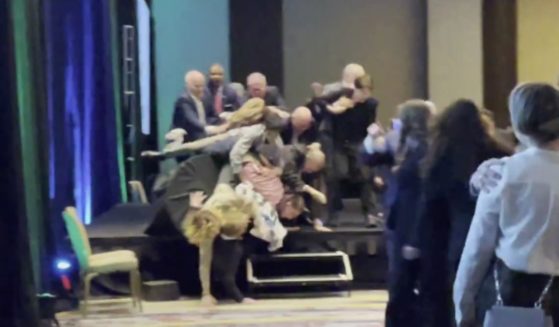German birthplace marks Bauhaus centenary with new museum
WEIMAR, Germany (AP) — The German city where the Bauhaus was born a century ago is paying tribute to the school behind a string of modern design icons with a new museum opening Friday meant to anchor it in its turbulent historical context.
The Bauhaus Museum in Weimar, a functional but elegant concrete cube designed by German architect Heike Hanada, showcases many of the items that blurred the lines between the artistic and the industrial — producing some of the precursors of modern mass design and helping make the Bauhaus influential far beyond its relatively brief existence.
Visitors can admire exhibits such as Peter Keler’s cradle made of a blue circle, a yellow triangle and red square, produced in 1922 under the direction of artist Wassily Kandinsky; Wilhelm Wagenfeld’s domed table lamp of 1924; Ludwig Mies van der Rohe’s steel easy chair and stool from 1929, and early precursors of the fitted kitchen.
But the museum also explores the wider and constantly shifting ambitions of the Bauhaus, which started work in April 1919 under architect Walter Gropius as Germany grappled with its political future after World War I. It reflects the political troubles that forced the school to move twice then close down shortly after the Nazis came to power in 1933.
The aim is not just to show off architecture and design but also to see the school and its leading lights “in their diversity, with their contradictions and how they are anchored in the 20th century,” said Benjamin-Immanuel Hoff, Thuringia state’s culture minister.
Weimar stands for both the high points of German classical culture and the low points of the country’s history. It was home to the poets Johann Wolfgang von Goethe and Friedrich Schiller and composer Franz Liszt, but later to the Nazis’ notorious Buchenwald concentration camp.
The new museum offers views toward the historical center and a tower built as a memorial to Buchenwald. It was built next door to the Gauforum, a monumental Nazi-era administrative complex and parade ground, where a permanent exhibit on Nazi slave labor is to open next year.
The Bauhaus itself fell foul of right-leaning local authorities in Weimar — long suspicious of its unconventional students and teachers — who slashed funding in 1925.
That forced it to move northeast to Dessau, then a rising industrial city, where the iconic glass-fronted Bauhaus headquarters and a residential estate with 90 apartments were built. Dessau’s Nazi-dominated council forced the Bauhaus to close in 1932, and an attempt by Mies van der Rohe — the last director — to keep it going in Berlin lasted only a few months.
Gropius, the first Bauhaus director, left Weimar a collection of 168 Bauhaus objects including ceramics, metalwork, furniture and rugs that is a mainstay of the museum’s collection. It survived World War II packed up in a room at Weimar’s city palace.
Curators are keen to stress that the Bauhaus didn’t come from nowhere, and the collection at the simultaneously restored Neues Museum nearby underlines that — showcasing work by Belgian designer Henry van de Velde and others that foreshadowed the school’s attempts to fuse fine and applied art. Bauhaus Museum director Ulrike Bestgen said it’s a myth that “everything was totally revolutionary and totally new.”
But Gropius and his associates took a very different direction. Gropius’ Bauhaus manifesto urged young people to “help work not just on physical construction but on a new society,” Bestgen said.
Bauhaus students had to learn a craft in one of 10 Bauhaus workshops. Those included a stage workshop, a kind of theatrical laboratory that explored movement, form and light.
Weimar is home to the small, cubic Haus am Horn, erected in 1923 as the first recognizably Bauhaus building. It is also where the Bauhaus started developing models intended for mass production. That idea intensified in Dessau — where a second new Bauhaus museum is expected to open in September.
Gropius’ successor, Hannes Mayer, stressed the school’s social aims and advocated producing “people’s necessities, not luxuries.” Meyer was blamed for the radicalization of students who turned to communism and was fired by the Dessau city council in 1930. His replacement, Mies van der Rohe, focused more on the aesthetics of architecture.
The Bauhaus was a “school as a big experiment for creative experiences,” Bestgen said.
“The Bauhaus kept correcting itself, kept coming up with new approaches to do things better, because they accepted that such a process of development includes failure.”
The Western Journal has not reviewed this Associated Press story prior to publication. Therefore, it may contain editorial bias or may in some other way not meet our normal editorial standards. It is provided to our readers as a service from The Western Journal.
Truth and Accuracy
We are committed to truth and accuracy in all of our journalism. Read our editorial standards.












